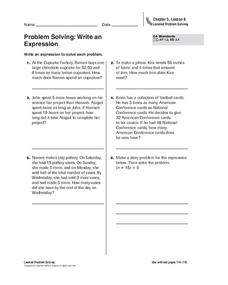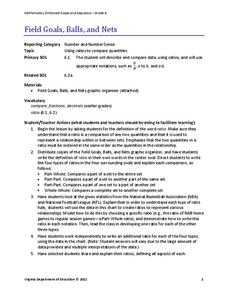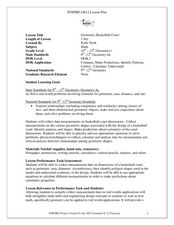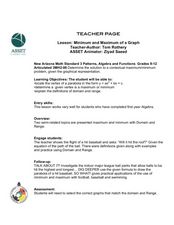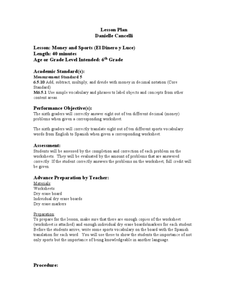Curated OER
The Football and Braking Distance: Model Data with Quadratic Functions
High schoolers engage in a lesson that is about the concept of data analysis with the use of quadratics. They use a Precalculus text in order to give guidance for independent practice and to serve as a source for the teacher to use. The...
Curated OER
Indirect Measurement with Similar Triangles
Students use similar triangles to find missing heights. For this using similar triangles to find missing heights lesson, students use proportions to find the heights of missing side lengths. Students find the height of trees...
Curated OER
Heads or Tails
Seventh graders compare experimental and theoretical probabilities. In this comparing experimental and theoretical probabilities lesson, 7th graders discuss the theoretical probability of flipping a coin. Students flip a coin...
Curated OER
Math: Football League Statistics
Students examine a soccer league final standings chart and then answer 12 questions based on the information provided. They calculate some answers in both fractions and percentages.
Curated OER
Elapsed Time Word Problems-- 24 Hour Clock
In this math learning exercise, students solve 20 word problems in which they calculate elapsed time to the nearest minute. The page is from the UK- spellings and idioms may be unfamiliar to others. Note: Some times are expressed on a 24...
Curated OER
Integer Intro
Read a series of word problems and have your class identify the process to solve them. They practice identifying, comparing, and ordering integers. They focus on recognizing opposites and the absolute value of number. An assessment...
EngageNY
The Difference Between Theoretical Probabilities and Estimated Probabilities
Flip a coin to determine whether the probability of heads is one-half. Pupils use simulated data to find the experimental probability of flipping a coin. Participants compare the long run relative frequency with the known theoretical...
EngageNY
Chance Experiments
Class members are introduced to probability using terms such as impossible, unlikely, likely, and certain. Numbers between zero and one are associated with the descriptions of probability. Pupils find the likelihood of chance experiments...
Curated OER
Problem Solving: Write an Expression
When practicing problem-solving skills students have to hone their critical thinking. In this worksheet on problem solving, 5th graders have to determine which operation and what strategy to use when answering the word problem. This...
Curated OER
Integers
Middle schoolers multiply integers. For this multiplying integers lesson, students multiply positive and negative integers. Middle schoolers discuss that a positives times positives, positives times negatives, and negatives...
Virginia Department of Education
Field Goals, Balls, and Nets
Score a resource on ratios. Young mathematicians learn about different ways to express ratios. Using sports data, they write statements about the statistics in ratio form.
Curated OER
Standard Linear Form
Ninth graders identify and describe the x-intercept as the place where the line crosses the x-axis as it applies to football. They create their own differentiations to reinforce the distinction between the x-intercept and the...
Curated OER
Model Data with Quadratic Functions
Students model data using quadratic equations. In this algebra lesson, students simplify and factor quadratic equations. They graph the function using collected data and analyze the parabola.
Curated OER
Matrix Operations
Students solve problems using matrices. In this algebra lesson, students add, subtract and multiply matrices. They use the graphing calculator to simplify and graph linear equations.
Curated OER
Geometric Basketball Court
Students calculate the area and perimeter of a basketball court. For this geometry lesson, students differentiate between similarity and congruence of geometric objects. They test conjectures and use it to solve problems.
Curated OER
Geometry of Exploration: Eyes Over Mars
Learners research how engineers and scientists generate linear and angular measurements with geometry to survey the Earth and Mars. They assess how geometric shapes affect navigation. A surveyor comes to the classroom and explains how he...
Curated OER
Minimum and Maximum of a Graph
Young scholars find the solutions of polynomials through graphing. In this algebra lesson, students identify the maximum and minimum of each polynomial function. They ind the vertex, domain and range of a parabola.
Curated OER
Subtract 13 and 14
In this subtraction practice learning exercise, students use problem solving skills in order to solve 6 math word problems that require them to subtract 1 digit numbers.
Curated OER
Determine the Coordinate of Transformations
Students investigate transformation on a coordinate plane. In this geometry lesson, students identify pairs of coordinates and their location on the grid. They perform rotation and reflection of each polygon.
Curated OER
Money and Sports
Sixth graders translate sports vocabulary words from English to Spanish and complete money problems containing decimals. In this money and sports lesson plan, 6th graders use words to communicate to each other.
Curated OER
Statistical Diagrams
In this statistics activity, students explore five activities that require analysis and interpretation of maps, charts, and scatter plots. The six page lesson includes five activities or experiments with short answer...
Curated OER
A Budget Can Help Young People Cut Their Spending
Students explore the concept of budgeting. In this budgeting instructional activity, students read an article about how a budget helps young adults keep track of their spending. Students discuss financial issues that young adults have to...
Curated OER
Area of Triangles - Word Problems
Here is an area of triangles practice worksheet in which learners sharpen their problem solving skills as they solve six story problems.
Curated OER
Compare Fractions Story Problems
In this fractions activity, students solve 6 story problems. Students will need to change fractions have common denominators before comparing them.










